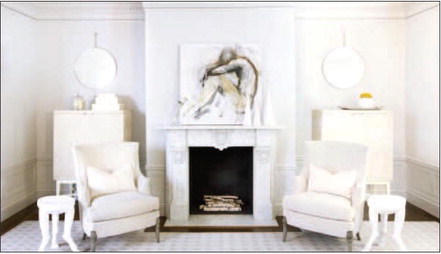‘Seamless color’ can make small spaces look larger
Even in a newconstruction home, every room may not be an ideal size. While your master bedroom and bathroom might be ample enough, the other bedrooms and bathrooms, perhaps even seating areas, might be less than impressive. Don’t despair. Carefully devised design solutions will allow you to convey the impression that a space is larger than it actually is.
Area designers offer simple tips to help you achieve this goal.
“Seamless color is an obvious way to make a space feel bigger than it is,” says Dawn Carlson, owner and principal designer of MAS Design in Berkeley. If you want to make a room look expansive, choose paint or a wall covering, furnishings and even flooring of the same or similar hue.
Of course, paler shades will make a space look larger. Consider cream-colored walls, sofa/love seat, armchairs and area rugs in a seating area, for example. In a dining space go with walls of pale beige and add drapes, table coverings
SMALL SPACES Page 2

A soft color palette creates cohesion and a sense of space and serenity while furnishings with an open underside impart a lighter feel. (Interior design by MAS Design; photography by Helynn Ospina)
and pendant lamps of the same shade.
Even where “there are a lot of interesting details,” instructs Carlson, a “soft color palette creates cohesion and a sense of space and serenity.”
“Dramatic impact via architectural details, finishes, wallpaper and art are all so important to elevating a space,” Carlson notes.
It’s not just about color.
“Moldings are a great (and cost-effective) way to create visual interest,” Carlson points out.
Adding moldings or trim to ceilings especially can heighten interest in an unexpected way. This technique can also act to draw the eye upward in a narrow or windowless room. As a bonus, crown or other moldings can contribute a touch of character to new-construction interiors.
And don’t discount the appeal of your own cherished objects. “Thoughtfully curated, personal pieces will make the most of a space while decreasing clutter,” advises Carlson. “Dramatic moments will keep the viewer engaged rather than focusing on the size of a space.”
Space perception, it seems, is more than merely visual.
“In my design practice, the concept of space is emotional, physical and mental,” declares Melisa LaBancz-Bleasdale of Apartment 46 for the Home in San Carlos.
“An easy-to-employ optical illusion is to trade solid furnishings for those that are more open ... Furnishings that allow you to see underneath and around them provide a huge dose of perceived space.”
Consider choosing armchairs, end tables, bedside tables, dressers and other furniture with an open underside. They’ll provide a lighter, less visually dense feel than pieces of identical dimensions that extend to the floor.
“One of our favorite tricks is to steal from the best designer of all time: Mother Nature,” explains Carlson. “Focusing a room toward the outdoors will allow for a sense of openness and peace.”
Whether you direct the eye toward sliding glass doors with a view of your backyard or optimize the vista from a kitchen/ dining area, focusing on nature distracts from any dimensional shortcomings of the interior space.
Even in the best of available floor plans, some rooms might be on the skimpy side. Carefully selecting furnishings, color palette and personal objects can make smaller spaces more inviting for homeowners and guests alike.

